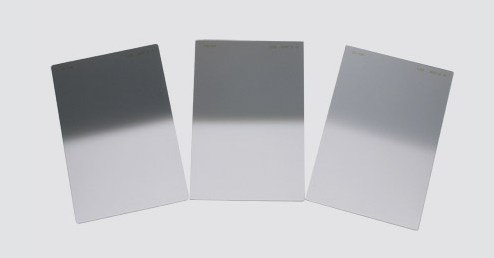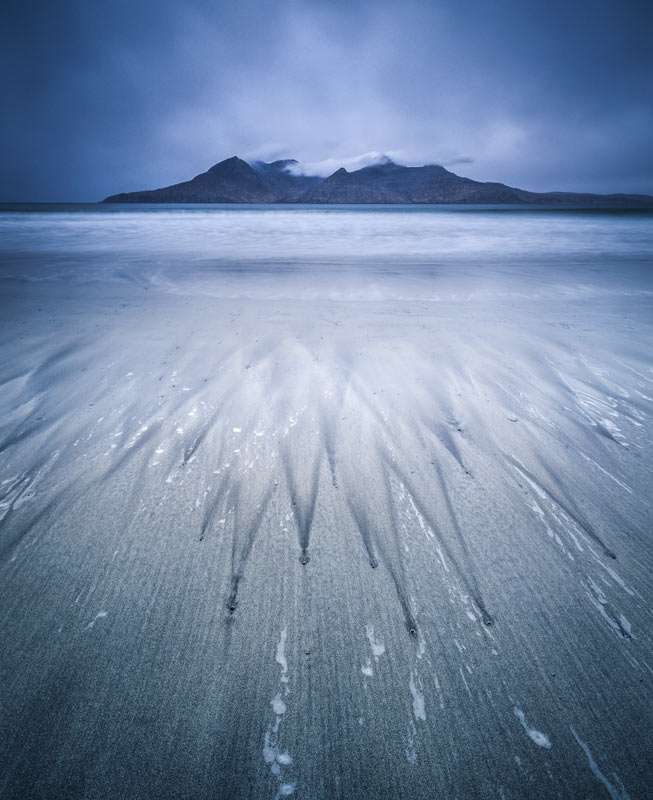Most of you all know about Graduated Neutral Density Filters. I for one, find them to be indispensable, even when shooting with a digital camera. (more info on how to use them here)
They are used balance the exposure within a scene – typically between the bright sky and dark foreground…(as in the Photo above of Peanut Lake)

Left to right: 3 stop Hard to 1 stop Hard ND Grad
One of the arguments against them is that you can accomplish this at home with your favorite editing software; create 2 exposures, one exposing for the ground, one exposing for the sky, combine them, and done.
That may be true, but one of the most unknown and biggest benefits of ND Grads is the ability to uncover contours, form, and shape in clouds. When you slide a ND grad down in front of your lens, the clouds and sky are darkened, and you are able to see these elements much easier. If you don’t use a grad in the field, it is much more difficult to discern these shapes, let alone try and find something in the foreground to mimic or compliment these contours, colors, and forms.
There are many factors that go into creating a great photograph. One of the most important techniques (that is often overlooked) is to create “Visual Relationships” within the frame. I believe if you can mimic or echo 1 or more of the following: shape, tonalities, form, or colors, you will create stronger compositions…this all becomes much easier with these fantastic little filters.
Below are some examples, rollover the images with your mouse or tap on the image to see some of the relationships reveled.
Shape, Color (complimentary), Tonality:
[himage]


[/himage]
Shape, Tonality:
[himage]


[/himage]
Shape, Tonality, Color (similar)
[himage]


[/himage]
Shape, Color (similar):
[himage]


[/himage]
Next time you are out shooting, try thinking in terms of creating Visual Relationships, and I guarantee you will create stronger compositions.
The best filters on the market are Lee Filters
Sorry, the comment form is closed at this time.


Catherine11 years ago
What incredible pictures and thanks for sharing your tips on the ND grad filters!
Raynor Czerwinski11 years ago
Thanks Catherine! I really appreciate you taking the time to let me know you liked the post 😉
Barbara Kauffman11 years ago
Best thing I’ve seen on Facebook! Thanks!
Raynor Czerwinski11 years ago
Thanks Barbara! Really appreciate it!
Jeremy11 years ago
just ordered Lee Grad ND soft filter set. can’t wait to use them.
Raynor Czerwinski11 years ago
Glad you got some Jeremy, I think you will find that the number your “keepers” will increase dramatically when using these.
jim masur11 years ago
Love your passion for the photography, plus I always take home at least one thing to practice
Dave10 years ago
Question about ND grads: What is your process in determining where to place the transition with a landscape that isn’t flat? I’ve been tempted to purchase a few ND grads but always ask myself if I’d use it since I am mostly in the mountains. Last question: Since these filters are not cheap, do you recommend a hard or soft transition. Thanks
Raynor Czerwinski10 years ago
Hey Dave,
Great questions…
Generally, you want to err on placing the grad lower rather than higher. It is quite easy to dodge (brighten) the mountain tops if the grad darkens them…whereas it is extremely difficult to do burn down (darken) the sky (from a high grad placement) to have an even transition from light to dark.
As for the soft or hard grads. If you are using a 35mm slr camera system, I would go with a 2 stop hard nd grad from lee filters (make sure to get the lee filter holder as well, its the best on the market).
If you want tom more flexibility down the road, get the 3 stop soft. Overall I find the 2 stop hard is the most used one in my collection.
Another note, the nd grads transition will increase in intensity the further you stop down i.e. f16 will be more pronounced than f5.6
as well as the wider the lens is, the more pronounced the transition will be.
Thanks for looking!